History of Medicine. Egypt

Medical practice in ancient Egypt was so developed that the western world could not surpass many of the observations and routine procedures for centuries after the fall of the Roman Empire. It was ancient Egyptian medicine that became the source of knowledge for the doctors of ancient Greece and Rome.
The Egyptians understood that the disease could be treated with pharmaceuticals, recognized the therapeutic potential of massage and aromatherapy, attached great importance to cleanliness in treating patients.
')
The fact that bacteria can serve as a source of diseases and infections became known even after the invention of the microscope - only in the XIX century, when this theory was confirmed by Louis Pasteur and proved by the work of the British surgeon Joseph Lister. However, even before their statements, the Hungarian doctor Ignaz Semmelweis in the XIX century suggested that doctors could reduce mortality among patients simply by washing their hands before the examination or by the operator.
The ancient Egyptians would certainly agree with the ideas of Semmelweis, since they highly valued purity. In ancient Egypt, the mortality rate after medical procedures was probably less than in any European hospital in the Christian era.
Injuries and illnesses
The Egyptians understood well how to cope with injuries, but it was much more difficult with illnesses. When a person is injured, it is easy to trace the cause and effect, and then cure. However, when a person is sick, the reason is less clear, and the diagnosis was a big problem.
The cause of the disease is usually understood as a consequence of sin or the attack of demons. Therefore, the first "doctors" tried to save the patient from the illness by reading spells. In addition, amulets, offerings to the gods, tattoos and statues designed to ward off evil spirits or soothe the gods who caused the disease were used.
Since that time, many papyruses have survived, in which spells are recorded. In some of them can be found and practical methods of treatment. For example, papyrus , dated 1200 BC, prescribes cannabis use for cancer patients.
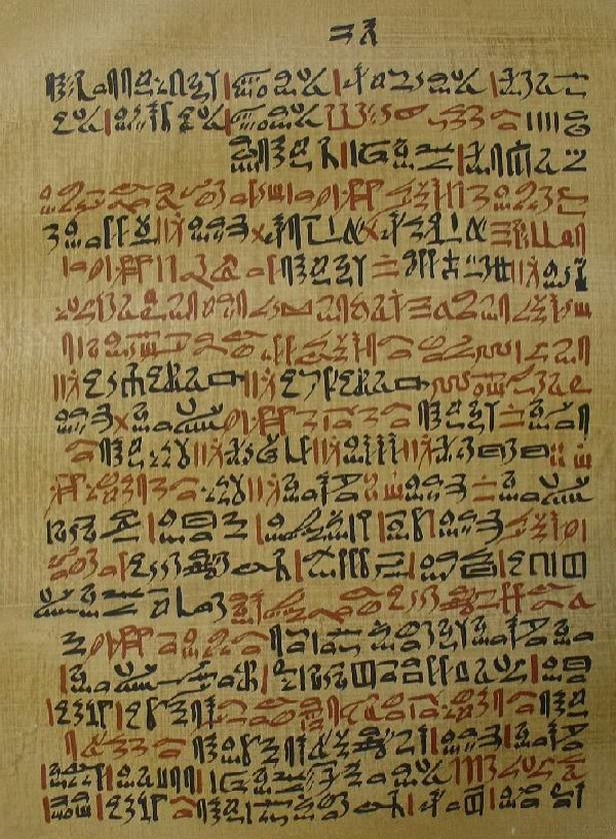
Another papyrus , the writing of which scientists attribute to the years 1570-1069 BC, describes the first ever methods of contraception and pregnancy tests.
In the densely populated Nile Valley, infectious diseases were widespread. Almost the entire population of Egypt then lived on a narrow strip of land along the river, which sometimes was only a few hundred meters wide. Diseases could be distinguished depending on the time of year.
Smallpox, dysentery, typhoid fever and jaundice most often overtook the Egyptians in spring and summer. Each year, the goddess Isis shed tears in her late husband Osiris, and the water level of the Nile rose from mid-July to September. Together with the fertile silt that helped the Egyptians survive, the river brought with it a specific set of diseases, the main of which was probably malaria - the main cause of death in late autumn. Cooler weather in winter favored the onset of respiratory diseases.
One of the most common complaints among Egyptians was eye infections. Fought it with bactericidal eye paint and drugs from the human brain. Here is what one of the universal recipes looks like, following which should have relieved not only the eye infection, but also all the problems in the body in general: “The human brain should be divided into two halves, mix half with honey, smear it in the evening. Dry the second half, sift, smear on the eye in the morning. "
Heavy physical work caused great harm to the joints and bones of the workers. Those who lived to old age, became victims of the same ailments, which are still suffering the elderly: cardiovascular diseases, arthritis and, probably, dementia.
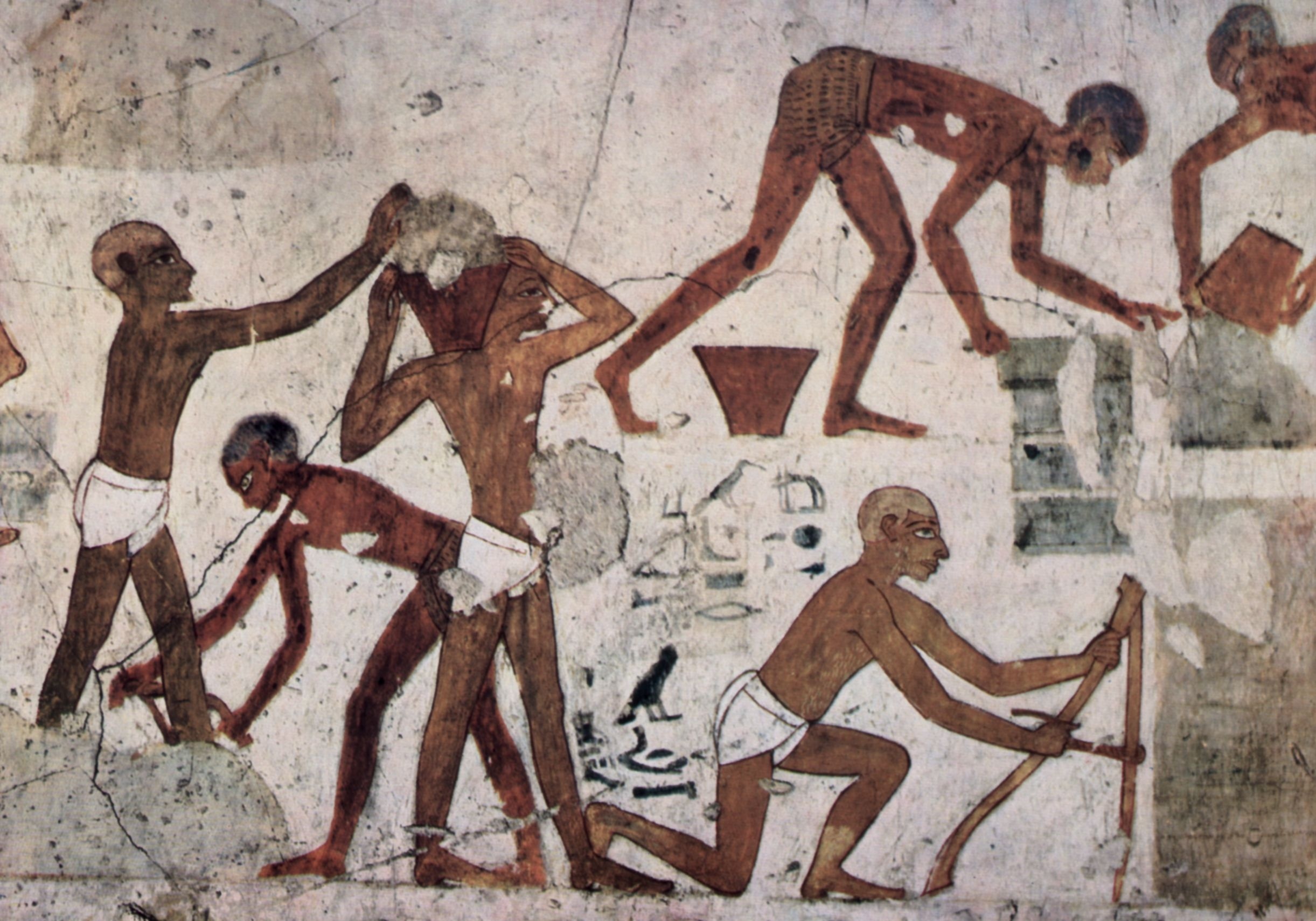
A restricted diet caused or aggravated a number of diseases, and in some cases even led to death. In ancient Egyptian history there were times when famine spread throughout the country. The data of ancient papyrus dentists indicate that during most of these periods, the health of the population deteriorated significantly, but with the more active introduction of agriculture, these problems were reduced to nothing.
The scarcity of the diet also influenced the growth of the Egyptians. The average growth of men did not exceed 160 cm, women - 150 cm.
Profession doctor
Nothing definite is known about how doctors received their medical knowledge. Historians suggest that after the Egyptian became a scribe, he became a student of a practicing healer. There is also an opinion that the “houses of life” associated with the goddess Sekhmet , the patroness of the doctors, were training centers for doctors.
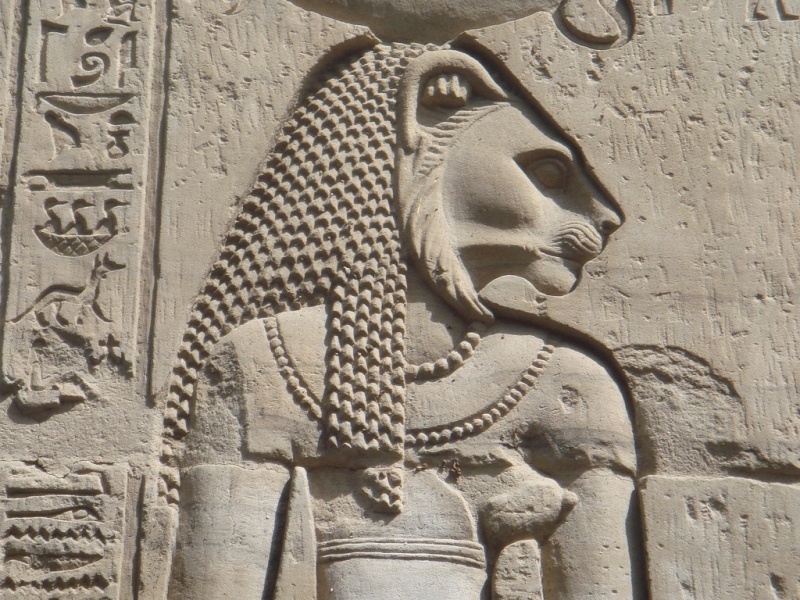
Goddess Sekhmet, bas-relief
Healers in ancient Egypt could become both men and women. The first doctor, later deified, was Imhotep, who combined the writing of medical works with the construction of the step pyramid of Djoser at Saqqara and was also a famous architect.
It was Imhotep who became the ancestor of secular medicine: he claimed that the disease originates naturally and is in no way connected with the spirits or revenge of the gods.
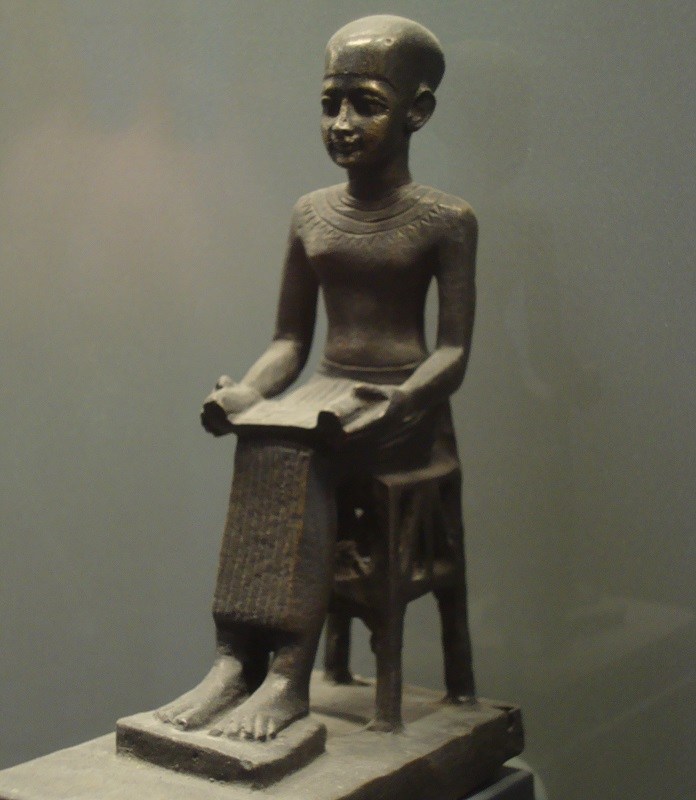
Imhotep's statue
The doctor was supposed to be not only literate, but also a pure soul and body. In Egypt, they were called “wabau” - ritually clean: they had to bathe as often and carefully as the high priests.
Each doctor had his own specialty, but “sunu” was distinguished - general practitioners, and “sa”, who specialized in magical rituals. Midwives, massage therapists, nurses, attendants and visionaries also helped the doctor.
Obstetrics, apparently, was the only female profession in ancient Egypt. Having studied the medical texts, which were written mostly by men, the scientists found that they contained a lot of information on gynecology in general, but none described obstetrics. In addition, men have never been portrayed in childbirth scenes.
There is no evidence of medical training for midwives. In the Old Kingdom (the period of the rule of Pharaoh III-VI dynasty) the word "midwife" is associated with nurses who helped the doctor, but after this period the connection between these two professions was lost. The midwives could be female relatives, friends, or neighbors. Apparently, they were not considered medical specialists.
The work of nurses could perform both men and women. The Egyptians respected nurses very much, although, like in the case of midwives, there was no evidence of school or vocational training anywhere. Nursing nurse was most appreciated.
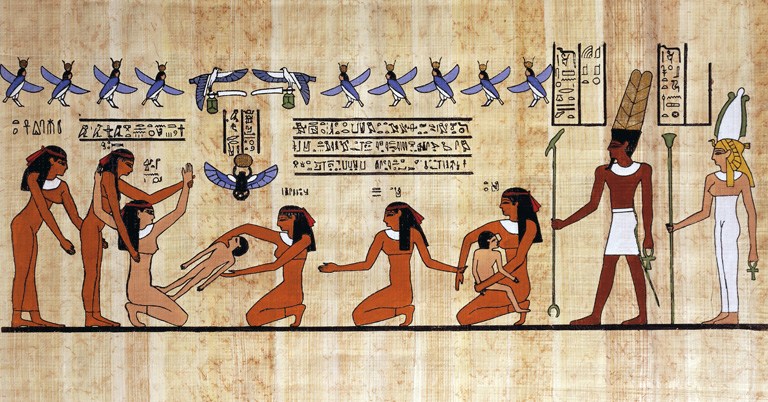
Women died regularly during childbirth, and in the legal documents of that time there were agreements between the nursery and the families about the care of the newborn in the event of the death of the mother. The nannies who helped with the upbringing of children were so respected that in the days of the New Kingdom (the era of the heyday of the ancient Egyptian state) they were tied to the divine.
Dental treatment
Ancient Egyptian dentistry grew out of the established medical profession, but it did not develop particularly widely. The ancient Egyptians suffered from dental problems throughout the history of civilization, but it was still not clear why there were not enough dentists (or mentioned them too rarely).

The first known dentist in the world was Hesire - the chief dentist at the court of Djoser (c. 2700 BC). Problems with the teeth arose mainly due to the consumption of coarse bread and the inability to completely remove the sand from their food. Dentists used honey and herbs to treat teeth, presumably to stop the infection or relieve pain. Dental bridges and gold teeth were found in some mummies. It is not known whether they were in the mouth during the life of the owner, or added in the process of embalming.
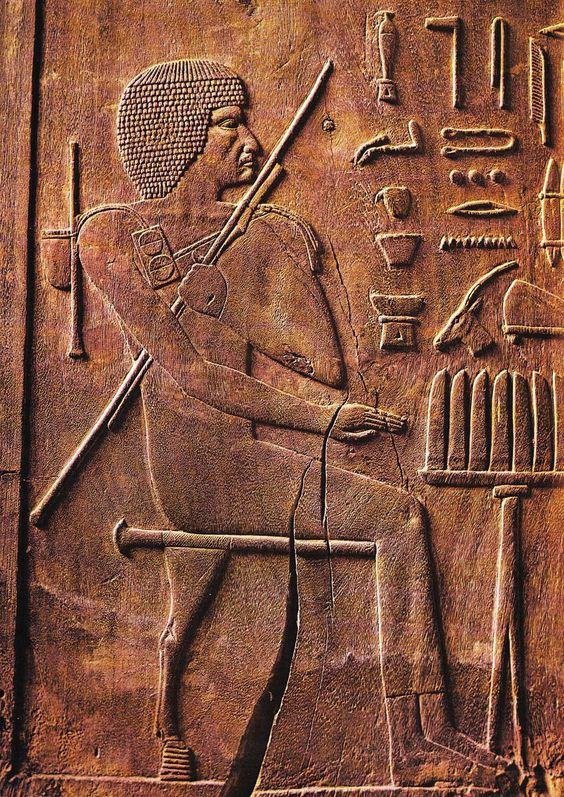
Hesire
The ruler Hatshepsut (1479-1458 BC) died of a tooth abscess. Such cases were not uncommon among her subjects. It was assumed that toothaches and other problems were caused by a toothworm, which had to be expelled by magic spells. This belief, most likely, originated in Mesopotamia, in particular, among the Sumerians, in the cuneiform records of which spells against the toothworm were found.
In addition to magic, Egyptian dentists used the healing power of herbs in their work. So, to save their patients from unpleasant smell from the mouth, they prepared chewing gum from honey, cinnamon, myrrh, frankincense and pignon. There is evidence of tooth extraction with opium used as an anesthetic.
Medical instruments
Belief in magic was deeply rooted in Egyptian culture and was considered as natural and normal as any other aspect of life. The god of magic Huck was also the god of medicine. In all the images he carries a staff entwined with two serpents. This symbol was subsequently passed to the Greeks, who linked him with the god of healing Asclepius, who today is known as the caduceus of the medical profession. And although the caduceus undoubtedly traveled from Egypt to Greece, it also appeared in Sumer as the staff Ninaza, the son of the Sumerian goddess of healing, Gull.
In addition to Huck, there were many other important healing gods, such as Sekhmet, Serket (also known as Selket ), Sebek, and Nefertum . All doctors were the priests of Cerketta, although not every doctor was a member of her cult. The help of Sobek, the god of crocodiles, was addressed during surgical operations and invasive procedures. Nefertum, the god of perfumes associated with lotus and healing, was invoked by procedures that today would be called aromatherapy.

Nefertum, statuette
The pharmaceutical preparations of the ancient Egyptian medical priests included antacids, copper salts, turpentine, alum, astringents, alkaline laxatives, diuretics, sedatives, spasmolytics, calcium carbonate and magnesia. The dosage of drugs was prescribed with special care in medical papyrus, the way in which the medicine should be taken orally (for example, with wine or food) was indicated.
Surgical procedures were common, and many of the instruments of that time are in one form or another used today. The Egyptians had flint and metal scalpels, pliers, bone saws, probes, catheters, clips to stop bleeding, speculums, tweezers, lancets for opening veins, sponges, scissors, bubbles, flax bandages and scales for calculating medicinal doses.
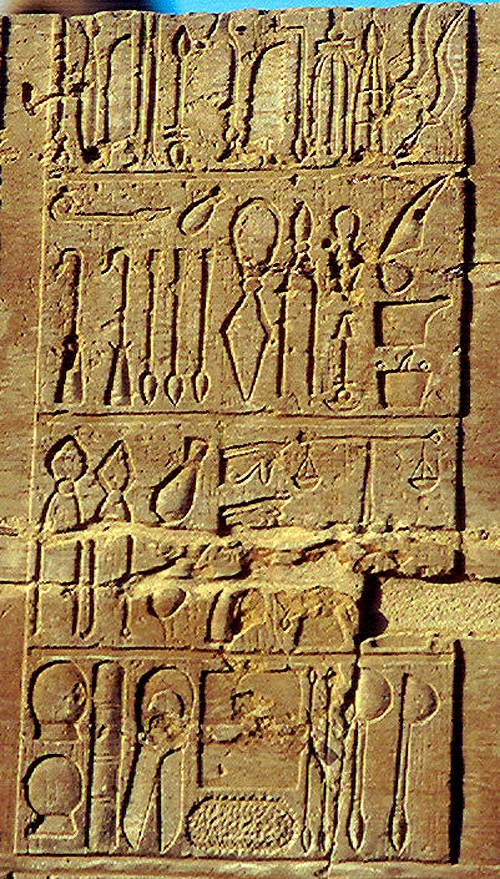
Surgical Instruments
Surgery was most often successful, as evidenced by the mummies and other found remains that survived amputations and even brain surgery. Dentures , usually carved from wood, were also found.
The role of ancient Egyptian medicine in history
However, not all medical practices were as successful in Egypt. For example, circumcision was a religious ritual in which boys between the ages of 10 and 14 were subjected to surgery, and meant a transition from adolescence to manly. Usually it was performed by doctors, who at the same time were priests of the temple. They used a flintblade and cast spells, but despite all the precautions, this procedure still sometimes led to infection.
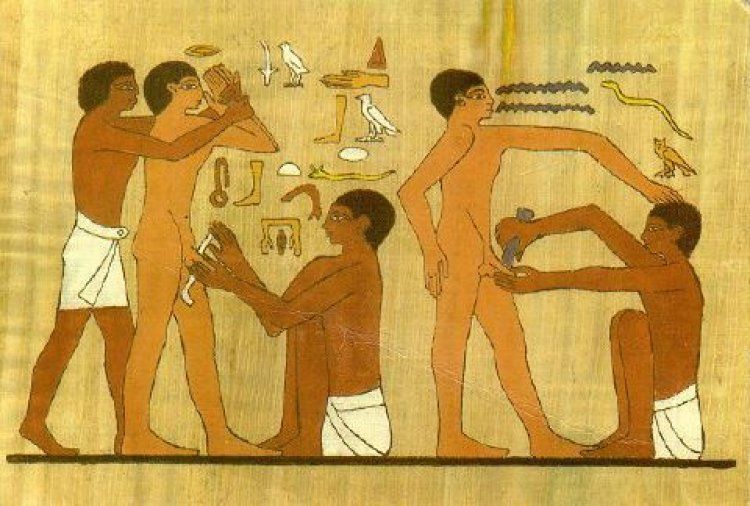
Circumcision procedure
Since the nature of the infection was unknown to the Egyptians, it was considered a result of supernatural influence. This approach most likely led to the death of many young people.
Egyptian physicians were in great demand in the Ancient World, despite the fact that probably little new knowledge appeared after 2000 BC. Their treatment was based on examination and diagnosis. The description of the case — the most demanding work of the doctor — lasted longer than the diagnosis or recommended treatment.
In general, the treatment was conservative: if the cure for the disease was unknown, then the doctor took some steps that would not jeopardize the patient’s life or relieve the symptoms. For example, some head wounds, which were then considered incurable, were treated with an infection ointment.
Although the embalmers of Egypt came to understand how the organs that they removed from their bodies were connected with each other, this knowledge was not shared with the doctors. These two professions developed in completely different directions, and what each of them did in their own direction of work was not considered relevant for the other.
A special relationship among the ancient Egyptians was formed with such an organ of the human body as the heart. In addition to being recognized as a “pump,” the heart was also considered the center of emotions, personality, and intelligence. For this reason, the hearts of the dead were preserved, and the brain was scraped and discarded as a useless organ.
Although they recognized liver disease, the Egyptians had no understanding of its functions. In ancient Egypt, they regularly dealt with the problems of miscarriages and infertility, but the mechanism of these processes was very vague ideas. The reliance of all culture on the supernatural help of the gods prevented the Egyptians from exploring more immediate and practical solutions to the medical problems they faced daily.
However, the Egyptian doctor was highly respected for his skills and knowledge; he was called to the court by pharaohs and nobles of other nations. The Greeks especially admired the Egyptian physicians, and adopted from them a number of beliefs and methods. Later, such famous doctors of Rome and Greece as Galen and Hippocrates studied Egyptian texts and symbols, thus transferring traditions and knowledge to the present day.
Source: https://habr.com/ru/post/403361/
All Articles